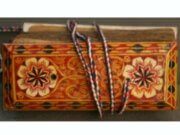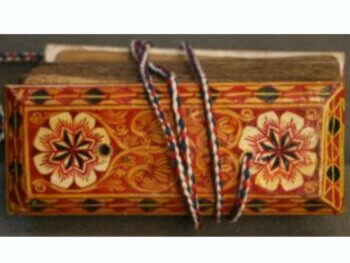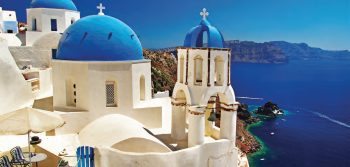
The Greek islands are like drops of paradise strewn throughout the glistening Mediterranean Sea offering any type of holiday imaginable. But with over 200 inhabited islands, how do you choose?
Boasting azure blue water and whitewashed villages, history and romance, diving and cycling, glam beach clubs and traditional taverns, temperatures soaring to 27 C and islanders who treat visitors like family, the Greek islands have something for everyone. Hold on to your summer hat as we breeze through Greece’s archipelago and highlight an ideal island for every type of traveller.
SANTORINI for Romantics
With its breathtaking views, glorious sunsets and whitewashed villages dotted with blue-domed churches spilling over the cliff, you can’t help but fall in love with Santorini — and fall in love while you’re there.
The crescent-shaped island is what remained after a massive volcanic eruption, some 3,500 years ago, created a water-filled caldera surrounded by 300-meter-high steep cliffs on three sides.
Stay on the west side of the island in one of the cliff-top villages to experience the postcard-famous Santorini. To up the romance, stay in a traditional cave house turned hotel, a suite with a private veranda overlooking the caldera and your own outdoor plunge pool or hot tub, or a hotel with an infinity pool that seems to be jutting out into the sea.
Laze on the black and red molten-dyed beaches, visit a winery, tour the excavation site of the Minoan Bronze Age settlement Akrotiri or visit Palea and Nea Kameni, volcanic islets formed by mild activity after the major eruption, where you can hike to the top of the steaming crater and swim in hot sulfur springs.
Be sure to spend an afternoon strolling through the bougainvillealined cobblestone streets of Oia (famous for its sunsets), where you’ll find plenty of shops, taverns, cafes and art galleries. Grab a seat on a caldera-facing patio, enjoy some of Santorini’s specialties (like tomato fritters and fava bean purée) with a bottle of the island’s award-winning wine and watch the sun sink into the Aegean.
MYKONOS for Party-goers
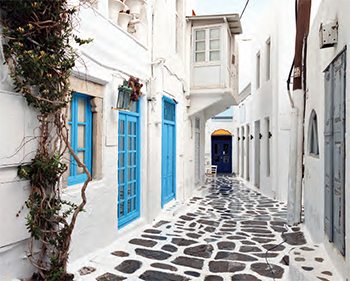 Often compared to Ibiza, Mykonos is famed for its wild, vibrant party scene.
Often compared to Ibiza, Mykonos is famed for its wild, vibrant party scene.
Hit the beach for a party during the day, with the most famous happening at Paradise Beach’s Tropicana Beach Bar. Super Paradise Beach draws an eclectic crowd and to keep it extra hot, swimsuits are optional. To escape the parties, sip on cocktails and soak up some sun at Psarou Beach, popular with locals and VIP visitors.
Start the evening in Little Venice, a charming spot on the water’s edge with medieval two- and three-storey houses turned chic bars. Continue into town where you’ll find piano bars, Irish pubs, gay bars, drag shows and nightclubs playing everything from house to hip hop to retro to rock. Head to the bouzoukia for live Greek music where you’ll find patrons tossing flowers and dancing on and around their tables or on stage next to the performers.
After-hour dining options are plentiful here. Enjoy a crêpe on the go or a gyro at Jimmy’s, a Mykonian institution. To continue partying, head to Paradise Beach’s Cavo Paradiso or Paradise Club — open-air clubs featuring big-name DJs.
Many hotels offer all-day breakfast for late risers but head over to the nearest bakery or pâtisserie for a strong Greek coffee or a frappé, a frothy iced coffee, and a traditional cheese, spinach, meat or custard pie, or some Greek yogurt drizzled with honey and pistachios.
If you see a pelican strolling leisurely through the alleyways beside you, it’s not from all the alcohol, that’s Petros the Pelican, the island’s mascot.
ALONNISOS for Nature-lovers
Still quite untouched by tourism, Alonnisos, with its forest-covered hills cascading down to the clear turquoise blue water below, is a nature- lover’s paradise.
Alonnisos, six smaller uninhabited islands, 22 islets and rocky outcrops, and the sea around them were declared a protected national marine park in 1992. The park is home to 300 fish species, 80 types of birds, a rare goat species and the endangered Mediterranean monk seal who find refuge in the caves along the coastline.
Certified sport divers and beginners acquiring their diving diploma on the island have much to see including sponges, corals, lamprey eels, scorpion and stripey fish, caves, amphorae shards, remnants of a sunken ancient city and many shipwrecks.
Explore the waters and islands on one of many boat tours or guided kayaking trips that leave time for hiking, swimming, snorkeling or relaxing on a secluded beach. While the monk seal is hard to spot, dolphins and whales are often seen.
Guided walks will take you by an archeological site, monasteries, churches and fishing villages and through countryside covered with strawberry and Judas trees, tree heather, Montpelier maples and olive groves. Look out for Eleonora’s falcons and a pair of Bonelli’s eagles that nest in the cliffs every year. Clear and marked paths and guide books and maps available at the harbour allow you to explore alone as well. Be sure to make your way to a tavern in the port village Steni Vala to enjoy a catch-of-the-day dish or the island’s specialty, lobster pasta.
RHODES for History Buffs
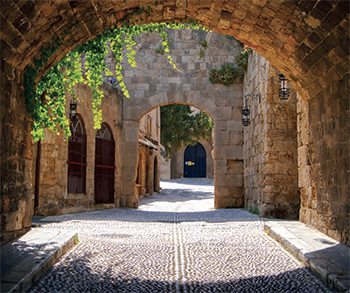 The magnificent Medieval City of Rhodes and its all-encompassing walls will have you feeling like you’ve stepped into the past, making Rhodes a must-see for historians.
The magnificent Medieval City of Rhodes and its all-encompassing walls will have you feeling like you’ve stepped into the past, making Rhodes a must-see for historians.
Once ruled by the Knights of St. John, this UNESCO World Heritage city is also known as Old Town and is one of the oldest inhabited medieval towns in Europe. Getting lost in the roughly 200 unnamed streets and lanes where locals live and work in century-old buildings is a pleasure. Don’t miss the cobble-paved Street of the Knights (or Odos Ippoton) where many of the inns of the crusading Order of the Knights of St. John were based, the Palace of the Grand Master at the highest point of the old city and the Church of our Lady of the Castle. Visit the many museums dotting the town and for the full experience, book your room at the Spirit of the Knights Boutique Hotel, a restored building in the medieval city.
Standing on a hill now known as Monte Smith is the Acropolis of Rhodes, an archeological park containing a stadium, an odeon, a gymnasium, the remains of the temple of Athena Polias and Zeus Polieus, and the temple of Pythian Apollo, and offering a panoramic view of the city and the sea.
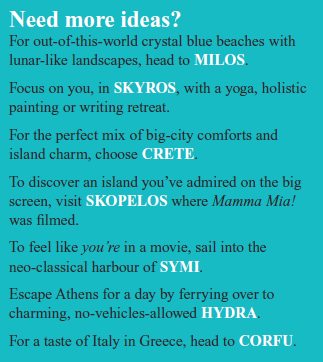 Climb (or ride a donkey) from the village of Lindos up to its famous Acropolis, where you’ll find the temple of Lindian Athena and the remains of an ancient amphitheater overlooking the Aegean.
Climb (or ride a donkey) from the village of Lindos up to its famous Acropolis, where you’ll find the temple of Lindian Athena and the remains of an ancient amphitheater overlooking the Aegean.
Other sites include Ancient Ialysos, Ancient Kamiros and several monasteries, churches and castles around the island. Two modern bronze deer statues, celebrating the unique species that has lived on the island for centuries, stand on either side of Mandraki Harbour, where the Colossus of Rhodes, one of the seven wonders of the ancient world, is said to have stood over 2000 years ago.
Before heading home, pick up some pottery pieces made on the island and a few boxes of melekounia — the traditional sweet of Rhodes made with sesame, honey and almonds — to share with friends and family.
BY SOPHIE TOLIAS
PHOTOGRAPHY BY FOTOLIA.COM
PUBLISHED IN THE BEAUTY ISSUE, SPRING/APRIL 2014
COMMENTS
YOU MAY ALSO LIKE
Newsletter Sign Up
Subscribe to our FREE newsletter for all of the latest news, articles, and videos delivered directly to your inbox each day!




